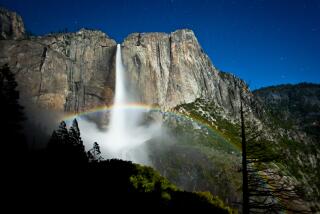A flaky winter in Yosemite
- Share via
Reporting from Yosemite National Park -- Winter in the high country is usually a season of icy quiet. Birds leave, bears hibernate, and only a few hardy people on skis or snowshoes pass through en route to snow-covered granite domes.
But Christmas and New Year’s Day came and went, then Martin Luther King Jr.’s birthday, and still only auburn pine needles covered the ground. Chattering squirrels, normally tucked away in their winter nests, perched on top of “Snow Play Area” signs, with no snow in sight.
Until a series of late January storms dropped more than 2 feet of snow — still far below the norm — many wondered if it was going to be the year the snows never came.
In this spine-country of grandeur and extremes, where people often mark time by natural events such as “the year of the big flood,” this is the year of the weird winter.
At Crane Flat Gas Station and Market, a final stopping point to the Yosemite-area back country, cashier Candy Moody watched customers come in wearing baseball caps instead of ski hats.
“You start wondering: OK, so is it never going to snow or are we going to get hit and hit hard?” she said on a mid-January day. “The whole year has been strange. No bears in the spring, and this place is usually crawling with bears.… Everything was turned upside down.”
Even for a La Niña year, this is an exceptionally dry season — the driest California has seen in more than 30 years. But while climate models predict that the Sierra snowpack will shrink in coming decades, those familiar with California’s weather history caution that in the short term, anomaly is the norm here.
“California is pretty much the most volatile place in the contiguous United States,” said Dan Cayan, a research meteorologist who heads the California Climate Change Center. “We’ve always seen huge variations in weather from year to year and decade to decade,” he said.
California 120 at Tioga Pass, about 10,000 feet high , offered rare unobstructed winter passage to the top of California until Jan. 17, the latest recorded date it’s been open since record keeping began in 1933. People flocked to ice skate on Tenaya Lake, which usually would be buried beneath snow. The lake gave off deep, booming sounds as the ice expanded in the sun.
“One family had a five-on-five hockey game on the ice. A bride walked out on the lake — a beautiful wedding dress on the frozen ice in the sun — everyone was rushing to take advantage of these probably once-in-a-lifetime opportunities,” said John DeGrazio, owner of Yexplore, a guide service. “I climbed Half Dome twice, ice-skated in short-sleeves. I was on top of Mt. Whitney on New Year’s Day.”
But by January, “fun, fun, fun” had turned to uneasiness, DeGrazio said. “People would start out talking about the next adventure, but it would turn into ‘When is the snow coming? What if the snow doesn’t come?’ ”
In the famed Yosemite Valley below, the only destination for the vast majority of tourists, the snow-less season created unusual sights well into January. All the roads were open. The only area closed was Badger Pass Ski Area. Staff at the hotels scrambled to set up rock climbing walls and archery practice to entertain would-be skiers. The bicycle rental stand was doing business. There were even mule rides.
Locals taking advantage of the mild weather and open roads helped make up for others postponing their trips — but ski tourism is a much bigger business than fair-weather tourism.
Jordan Creamer, a bartender and waiter at Tenaya Lodge, saw 200 guests cancel their reservations in one day.
On the other hand, because business at the lodge was slow, Creamer, 27, had Christmas off for the first time in his adult life, so his family, including his brother, Dodgers pitcher Ted Lilly, came to his house for the holiday.
At the park’s south entrance, rangers Donna Dozier and Corey Kniss grew weary, week after week, of the question “Where’s the snow?” Dozier bought a can of artificial snow and sprayed the windows of their stand so they could point to something white. In the window, in the fake dusting, she wrote, “Let It Snow.”
When the storms did come, lasting Thursday to Monday, they dropped mostly rain at the lower elevations.
It took a heavy toll. Because there had been no previous rain, dry ground was swept away. Gusting winds wreaked havoc. On Saturday, a branch fell from a huge tree, killing a 27-year-old ranger who was asleep in his tent cabin.
The next day, a rock slide took out a section of a main highway into the park.
California 120, the route that most Bay Area residents use to get to Yosemite, is closed indefinitely.
There is snow. Badger Pass Ski Area, which does not make its own snow, was expected to open Thursday. But even though Yosemite is known to have big March snowstorms (last year, on March 20, the last day of winter, a storm dumped three feet of snow, closing all highway entrances and prompting an evacuation) total snowfall is likely to be far less normal.
This week at the south entrance, there was rain, sun and brief periods of big, feathery snowflakes, leaving only a light dusting of white on the landscape.
Dozier added one more word to her “Let It Snow” message: “more.”
More to Read
Sign up for Essential California
The most important California stories and recommendations in your inbox every morning.
You may occasionally receive promotional content from the Los Angeles Times.











